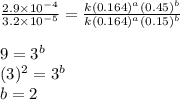
Chemistry, 13.12.2019 23:31 albattatasraap5wymy
Consider the following reaction between mercury(ii) chloride and oxalate ion:
2hgcl2(aq)+c2o2−4(aq)→2cl−(aq)+2co2 (g)+hg2cl2(s)
the initial rate of this reaction was determined for several concentrations of hgcl2 and c2o2−4, and the following rate data were obtained for the rate of disappearance of c2o2−4:
experiment hgcl2(m) c2o2−4(m) rate (m/s)
1 0.164 0.15 3.2×10^−5
2 0.164 0.45 2.9×10^−4
3 0.082 0.45 1.4×10^−4
4 0.246 0.15 4.8×10^−5
what is the reaction rate when the concentration of hgcl2 is 0.135 m and that of c2o2−4 is 0.40 m , if the temperature is the same as that used to obtain the data shown?

Answers: 2
Another question on Chemistry

Chemistry, 21.06.2019 22:30
Often on a topographic map, every fifth contour line is darkened. what is this line called? a. key b.slope c.benchmark d. index contour
Answers: 1

Chemistry, 22.06.2019 08:30
Analyze how limestone is weathered and identify the features that are formed as a result of this dissolution
Answers: 1


Chemistry, 22.06.2019 15:10
The ozone molecule o3 has a permanent dipole moment of 1.8×10−30 cm. although the molecule is very slightly bent-which is why it has a dipole moment-it can be modeled as a uniform rod of length 2.5×10−10 m with the dipole moment perpendicular to the axis of the rod. suppose an ozone molecule is in a 8000 n/c uniform electric field. in equilibrium, the dipole moment is aligned with the electric field. but if the molecule is rotated by a small angle and released, it will oscillate back and forth in simple harmonic motion.what is the frequency f of oscillation?
Answers: 2
You know the right answer?
Consider the following reaction between mercury(ii) chloride and oxalate ion:
2hgcl2(aq)+c2o2...
2hgcl2(aq)+c2o2...
Questions












Social Studies, 14.08.2020 01:01


History, 14.08.2020 01:01





Chemistry, 14.08.2020 01:01



![\text{Rate}=k[HgCl_2]^a[C_2O_2^{4-}]^b](/tpl/images/0417/7719/2a902.png)


 ....(1)
....(1) ....(2)
....(2) ....(3)
....(3) ....(4)
....(4)

![\text{Rate}=k[HgCl_2]^1[C_2O_2^{4-}]^2](/tpl/images/0417/7719/2292e.png)


 is 0.40 M.
is 0.40 M.



